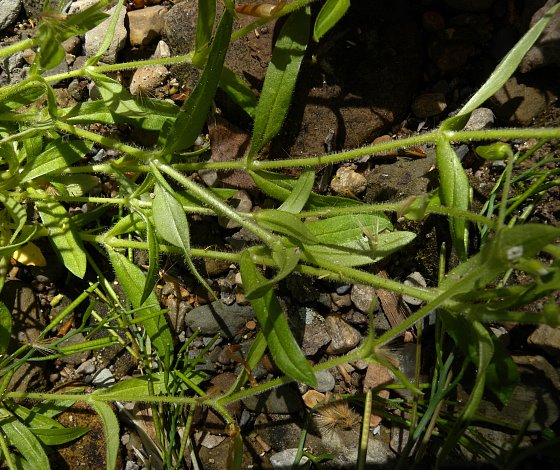
The upper stems terminate in either cymes or compound cymes of flowers (usually the latter); these cymes are dichotomously branched and variable in size. Each terminal branch of the inflorescence typically has 3 flowers with divergent slender pedicels up to 1¼" long. While the flower buds are nodding, the flowers are more erect. Similar to the stems, the branches and pedicels of each inflorescence are light green, terete, and glandular-pubescent. At the base of each pair of branches in an inflorescence, there is a pair of leafy bracts up to ¾" and 5 mm. across. These bracts are lanceolate in shape and they lack membranous margins. The flowers are up to ¼" across while they are in bloom. Each flower has 5 white petals with notched tips, 5 green sepals, an ovary with 5 styles, and 10 stamens (usually). The sepals are lanceolate in shape with membranous margins and short-pubescent; they are about 3-5 mm. long. The petals are the same length or a little longer than the sepals. The blooming period occurs from mid-spring to early summer, lasting about 1 month. Usually, only a few flowers are in bloom at the same time. Sometimes cleistogamous flowers that fail to open are produced.
Cultivation: The preference is full sun to light shade and moist conditions. Nodding Chickweed is not particular about soil. Most growth and development occurs during the spring when the weather is cool and moist, after which the foliage dies down.
Range & Habitat: The native Nodding Chickweed is occasional to locally common in most areas of Illinois. Habitats include floodplain woodlands, streambanks in wooded areas, ravines and ledges along streams, gravel bars along rivers, weedy meadows, nursery plots, and moist waste areas. Nodding Chickweed occurs in both natural areas and human-mediated environments. In natural areas, it tends to occur in places where there is some disturbance by the action of water (e.g., soil erosion or deposits of gravel).
Faunal Associations: The flowers are cross-pollinated by honeybees, Halictid bees (Halictus spp., Lasioglossum spp.), small butterflies, Syrphid flies, and other flies (Robertson, 1929). Both nectar and pollen are available as floral rewards. The caterpillars and cutworms of various moths are known to feed on chickweeds (Stellaria spp., Cerastium spp.). These moth species include Haematopis grataria (Chickweed Geometer), Lobocleta ossularia (Drab Brown Wave), Agrotis venerabilis (Venerable Dart), Hyles lineata (White-Lined Sphinx), Feltia jaculifera (Dingy Cutworm), Xestia badinodis (Spot-Sided Cutworm), and Xanthorhoe ferrugata (Red Twin-Spot). Vertebrate animals also feed on these plants to some extent. Various sparrows and other granivorous songbirds eat the seeds, while deer, rabbits, and domesticated farm animals (cattle, horses, sheep, & pigs) occasionally browse on the foliage.
Photographic Location: A gravel bar along a river in a wooded area of Pine Hills State Nature Preserve in west-central Indiana.

Comments: Notwithstanding its weedy appearance and habits, this is one of the native chickweeds in Illinois. It is a rather floppy plant with small white flowers. Nodding Chickweed can be distinguished from other chickweeds (Stellaria spp., Cerastium spp.) by the shape of its leaves, diffuse inflorescence, and structure of its flowers. In particular, the pedicels of its flowers are rather long (1" in length or more) and divergent, while its flowerbuds and seed capsules nod downward. Among the Mouse-Eared Chickweeds (Cerastium spp.), Nodding Chickweed has rather long and narrow leaves. Some authorities consider the more western Cerastium brachypodum to be a variety of Nodding Chickweed, or Cerastium nutans obtectum. This latter species (or variety) tends to have more hairy leaves and its pedicels are shorter (less than 1" in length).